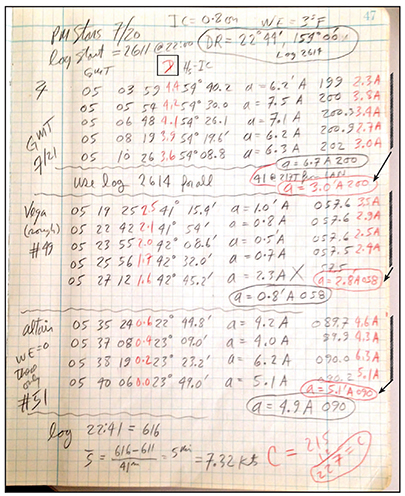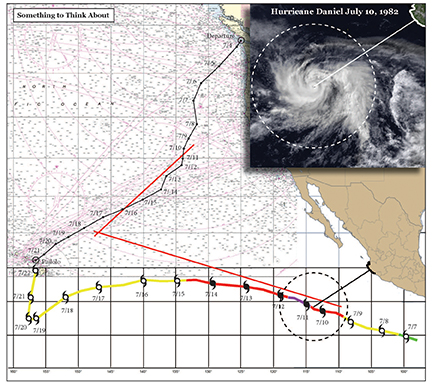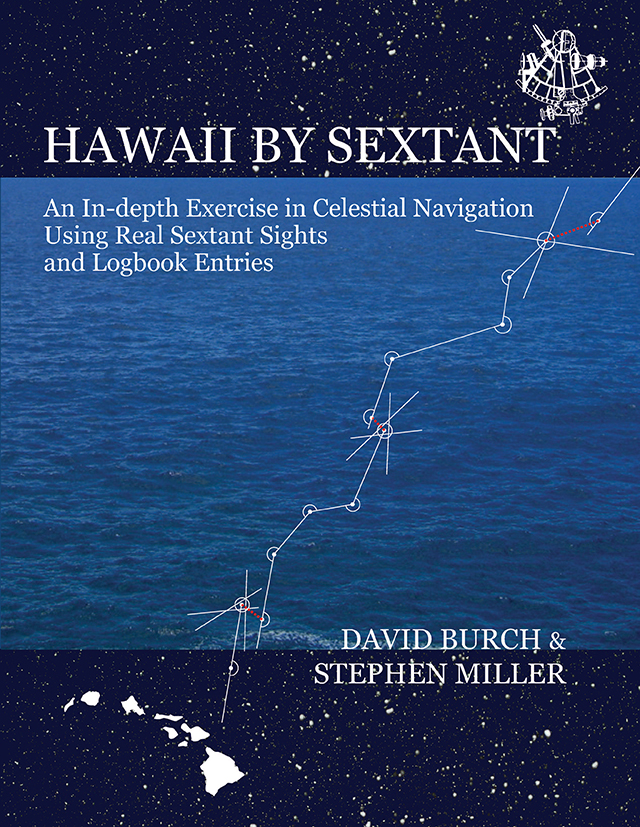How to learn and practice celestial navigation using data from a 2,800 mile ocean passage (published May 2014)
Most blue water sailors think about learning celestial navigation (cel nav) at some point. Many pursue it so they can navigate on their own if they need to. They do, after all, have a boat that can proceed without power—nor any other communications with civilization— so why not learn how to navigate it in those conditions.
Until recently, a sailor would learn cel nav from textbooks using carefully crafted examples of sextant sights, and thus learn how the process works. But the real world usually differs from the classroom, so we are left to learn the practical matters on the wing, when we really need it. A new book from Starpath Publications called Hawaii by Sextant (starpath.com/HBS) takes a unique step forward to changing the options we have for learning cel nav by bringing the real world into the classroom.
The book is a documentation of the ocean passage from Victoria, British Columbia to Maui, Hawaii carried out in 1982, when cel nav was the only means of navigation available, other than log and compass. The essence of the study is the logbook of course changes done between the celestial fixes, along with watch times and sextant readings to each of the bodies sighted. The work is unique in that even the classic early texts of Bowditch and others used manufactured data for their training voyages, whereas this book uses real data.
The boat was taking part in the Vic-Maui yacht race (vicmaui.org, even years), one of the three popular races to Hawaii from the West Coast, including the Transpac (transpacyc.com, odd years) from Los Angeles to Honolulu, and the Pacific Cup (pacificcup.org, even years) from San Francisco to Kaneohe Bay, Oahu.
The study includes over 220 sextant sights making up 27 position fixes over the 2,800 miles logged that lasted 17 days. It was a slow passage for a yacht race, but it was not uneventful, and in long retrospect offers us much to learn about navigation of a small boat across the ocean. There were dead calms (crew swimming in the ocean) and 40-knot squalls with rain so hard you could not see the bow of this 40-foot boat. That under-the-faucet experience of what is called violent rain remains one of the striking memories of the trip.
Here are a few key points we are reminded of from this new study of practical celestial navigation.
What you need
The basics are: a sextant, a watch with known error and rate, sight reduction tables, a nautical almanac and universal plotting sheets. With a metal sextant and standard books, this costs about $900. With a plastic sextant and minimalist books, it is about $100. The minimal approach takes more work and won’t be as accurate, but does reflect what a safe backup package would cost.
What accuracy can you achieve?
With practiced use of a metal sextant, employing good procedures, in good conditions, you can find your position underway within an accuracy of 1 nautical mile. Pushing this to the limits might get you half of that, but never better, and indeed rarely that. More routinely, a position within 2 to 5 nautical miles is more likely. Much worse than that, means something is not being done properly. The keys are good procedures and proper accounting for the motion of the boat during the time of sight taking.
When do you do it
Sun and moon sights can be taken at your convenience during the day. Star and planet sights are only available in morning or evening twilight when you can see both the bodies and the horizon—typically a 30-minute window, depending on latitude. You have a long time in Alaska (assuming the sky is clear), but the “sun comes up like thunder on the road to Mandalay.”
When relying on cel nav exclusively, you try to get star sights either in the evening or morning, and one fix from the sun during the day. But this will not always be possible, either because of the sky or because of your schedule. In the summer the nights are short, so morning or evening plus one day session is usually enough. When the sky is overcast or cloudy, you have to take every sight you can, because you don’t know when you won’t get anything.

How do you do it?
With the sextant, you measure the angular height of the body above the horizon and carefully note the time to the second. The goal in star-planet sights is to do this four or five times for each of three bodies, roughly 120 degrees apart in bearing. That is the ideal. In practice you take what you can get in the time you have. With these sights you can then figure where you were at the time of the sight taking. But clearly, if you are moving at 7 knots and it takes 30 minutes to do the sights, you have to choose a time, and adjust all sights to that time.
For the sun navigation you choose a time, take three or four measurements at about a minute or so apart, then wait for the bearing to the sun to change 30 or 40 degrees and do it again. Then, using your dead reckoning (DR) between sights, you advance the first sights to the second for what is called a running fix. It is just as good as star sights if you have a good DR between the sights.
A daylight sun-moon fix is a bonus available a couple weeks each month. A prominent moon at twilight is usually more trouble than it is worth; it distorts the horizon. The bright planets Venus and Jupiter are always a bonus as they can be seen in the daylight phase of twilight, when the horizon is sharp.
Then comes the paperwork, called sight reduction. With a programmed calculator or computer program you can do everything you need in a matter of 20 minutes or so to find a position. Doing it all by hand with tables and plotting, it will take about an hour to get a fix, or twice that to do the best you can. We have to accept that this is more work in a moving nav station than it is at the kitchen table where we learned to do it. But not so much as it might seem, because everything we do at sea is harder than on land, and at some point we simply adapt to this moving world. At home you would get mad if someone jerked the chair out from under you every few minutes as you tried to concentrate, but after a few days at sea, you just get up and keep working, or figure out a way to stay in your chair.
The importance of ocean DR
Besides having a record of actual sights and logbook records in all manner of conditions with multiple examples of having to pull a fix out of limited data, we see in practice the main reason we do celestial navigation. It is not so much just finding out where we are; the main goal is to learn how well we can navigate without it. In other words, we use it to test our DR.
It is precisely the same goal we should have today crossing the ocean using GPS. Each time we get a fix, we compare that fix with where we think we should be based on our log and compass records, adjusted as needed by how we think the current and wind have affected our progress.
No matter how we navigate routinely (cel nav or GPS) the main goal of prudent navigation is to learn how well you can navigate without it, with no electronics and with the sky socked in or no usable horizon. A lack of clear horizon is as often a showstopper to cel nav as is an overcast sky.
The question addressed is how accurately can we expect to navigate by DR alone? The proposal we have used for years is that you must think of this in two ways. First, consider a position uncertainty that is growing at the rate of 7 percent of your distance run, and at the same time assume you are in a current of 0.7 knots in a direction you do not know. After logging 100 miles with good records of all course changes (assuming calibrated instruments) and accounting for leeway and any known or predicted currents, we must assume our position is uncertain by 7 nautical miles. If this run takes us 24 hours, then we have an additional position uncertainty of 17 miles (0.7 x 24). These combine as the square root of the sum of the squares for an uncertainty of about 18 miles.
In that example, the time dominated. Traveling at 10 knots for the 100 miles, the error current adds only 7 miles to the uncertainty. This does not mean you are wrong that much, it just means that is the uncertainty you must use when making decisions on your route based on DR alone. The larger error will dominate in this statistical addition.

Mesocale current eddies
A day to day study of this comparison and what you can learn from it is covered in this book, and one of the things that stands out is a weeklong shift of the DR to the east, in what was effectively an error current of about 1 knot. This observation was not fully appreciated at the time of the voyage, though it was indeed recognized. Since that time (1982), oceanographers have learned a lot about ocean currents. That shift of the DR to the east was almost certainly the work of an unforeseen mesoscale current eddy. The speed and size are consistent. The DR before and after that was normal.
These are loose canon circulations of the ocean surface that form and migrate and dissipate in seemingly random fashion, though indeed there is a complex theory behind each one, just as there is to the water surface in a washing machine. It is just difficult to predict. Modern ocean models are getting much better at this, but they have a long way to go for routine application. We have extensive notes on this at starpath.com/currents.
The main message is that ocean currents can be larger and quite different from those predicted on Pilot Charts and we should be on the alert for their effect.
Tropical storm forecasting
Another reminder we get from that 1982 voyage is the value of modern tropical storm guidelines we get from the National Hurricane Center (nhc.noaa.gov/prepare/marine.php). One is the “34-knot Rule” telling us to avoid the forecasted region around the storm that has winds stronger than 34 knots. This region is included in the forecasts and reports. The second is the “Mariner’s 1-2-3 Rule” that tells us how the uncertainty in the predicted storm location increases with the forecast days: 100 miles for 1 day, 200 miles for 2 days, and 300 miles for 3 days.
In 1982 we were on a collision course with Hurricane Daniel for about 10 days, after which, the system degraded to a tropical storm and altered course to the south. As it turned out, we both got to Hawaii at the same time, and we did experience remarkable squalls possibly associated with that system. Had we known these NHC rules then, we would have had more quantitative guidelines to consider. What was left mostly unsaid on the boat at the time was that we never were out of a collision course with the system, because the statistical path of such storms was a curve pole-ward, straight at us.
Always old, always new
I encourage ocean sailors to have a look at this book for a modern review of the oldest way to navigate and to keep in mind our own guideline to prudent, efficient navigation: always old, always new.

















